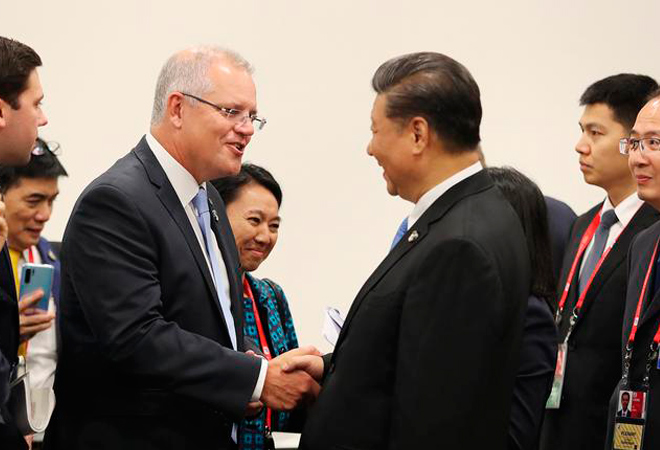 This is the 112th article in the series
This is the 112th article in the series The China Chronicles.
Read the articles here.
Despite varying political systems and conflicting alliances, China–Australia bilateral relationship has continued to flourish over the years through mutually beneficial trade links. However, relations between the two countries started to ebb in 2017 amidst concerns about China’s growing political influence on decision-making in Australia. The COVID-19 pandemic further exacerbated the tensions between the two countries. After Canberra demanded an independent inquiry into the origins and spread of COVID-19, the relations plummeted and swiftly spiralled downwards by the end of 2020.
The cold politics finally spilled over to economic ties, impacting trade and investment ties between the two countries. China was quick to implement tariffs and export controls on its imports of goods from Australia—threatening US $25 billion worth of Australian exports. China’s subsequent changes in trade policies have been construed as economic coercion against Australia. A clear understanding of the implications of the tensions for both economies offers a view of the forthcoming trade trajectory and geoeconomic consequences.
Deteriorating relations between China–Australia
While Australia’s ‘independent review for COVID-19’ is often cited as the reason for the trade rift, Australia–China tensions were already simmering from within. Strains in the Sino-Australian relations were palpable after Australia raised security concerns over Chinese involvement in 5G wireless networks and excluded Chinese companies such as Huawei and ZTE from participating in the country’s 5G rollout in 2018.
Another area of contention involves Australia’s denouncement of human rights abuse regarding the mistreatment of Uyghurs and other minority groups in the Xinjiang region in 2019. Beijing also expressed its displeasure over Australia’s open opposition to the Hong Kong national security law, after which Australia suspended the extradition treaty with Hong Kong in June 2020. Suspicious of the strengthening Australia–United States (US) alliance, China views any opposition over issues such as Hong Kong, Tibet, and Xinjiang as a threat to Chinese sovereignty.
In November 2020, the Chinese embassy released a list of grievances against Australia, including issues such as funding “anti-China” research, raids on Chinese journalists and “spearheading a crusade” against China in multilateral forums. The situation further worsened when the spokesman for the Chinese Ministry of Foreign Affairs posted an allegedly fabricated image of an Australian soldier with a knife to the throat of an Afghan child. In the most recent turn of events, Foreign Minister Marise Payne cancelled a non-binding memorandum of understanding (MoU) and “Framework Agreement” regarding the Belt and Road Initiative (BRI) between China and the state of Victoria.
China’s trade actions against Australia
The economic relations between the two countries witnessed a boost when they signed the China-Australia Free Trade Agreement (ChAFTA) in 2015. Since then, businesses in both countries utilised lower tariffs to deliver economic benefits at both ends. Following the ChAFTA, the value of exported goods to China doubled in five years from A$ 75 billion in 2014–15 to A$ 150 billion in 2019-20. China remains Australia’s largest trading partner in goods and services, accounting for nearly 40 percent of all goods exported in 2019–20. In 2019–20, the two-way trade crossed A $251 billion, with Australia’s exports increasing by 9 percent to reach A $168 billion.
However, by the end of 2020, the situation has markedly altered—several Australian industries were affected by a round of tariffs and trade actions by the Chinese government. In May 2020, China imposed an anti-dumping duty of 73.6 percent on Australian barley exports. Following the anti-dumping tariffs, the Chinese authorities also banned beef, coal, copper, cotton, seafood, sugar, timber, and wine exports from Australia. According to the Australian Bureau of Agricultural and Resource Economics, losing the Chinese market would cost them approximately about 30 percent of the value of lost barley or US $330 million a year. Similarly, beef exports were down by 22 percent in the first three quarters of 2020.
While tariffs on Australian wine were earlier reduced from 14–20 percent in 2014 to zero in January 2019 under ChAFTA, in November 2020 China imposed anti-dumping provisional tariffs of 107.1 percent to 212.1 percent on Australian wine. Australia is a major exporter of wine to China, accounting for 39 percent of Australia’s wine exports. According to a study by Wittwer and Anderson, Australia’s loss in exports to China will amount to US $785 million per year; however, it is likely to be offset by export diverted to other countries—thus leading to a net reduction of US $225 million. The protectionist measure is likely a reflection of China’s economic self-reliance programme; however, the decision amidst bilateral tensions invariably points towards Chinese economic coercion.
China’s logic of economic coercion is seemingly based on asymmetry of costs, where China seeks to impose tariffs on Australia on selected goods that have high coercive value. In other words, the selected goods for tariffs can be easily substituted and will be of low cost to China.
Two sectors—wherein China’s reliance on Australian exports is high—were spared export restrictions. Both iron ore and natural gas are crucial for the Chinese steel industry and its goal of carbon neutrality respectively. China, however, had claimed that the sanctions were highly technical and not coercive in nature.
While neither country has extended an olive branch, the BRI cancellation is likely to exacerbate the current rift between the two countries. A renewed relationship and restored trust between Australia and China will take significant effort from both ends. Australia, as a Pacific middle power, faces a political and economic dilemma in the atmosphere of growing geopolitical tensions in the Asia Pacific region. Australia’s diplomatic strategy will considerably determine its trade trajectory in the coming months; enhancing the resilience of supply chains is now more important than ever for Australia to counter economic coercion. As China’s economic statecraft makes a comeback, Asian economies are likely to closely monitor any further development of China–Australia tensions and reassess their trade reliance on China.
The views expressed above belong to the author(s). ORF research and analyses now available on Telegram! Click here to access our curated content — blogs, longforms and interviews.



 This is the 112th article in the series The China Chronicles.
Read the articles
This is the 112th article in the series The China Chronicles.
Read the articles  PREV
PREV


